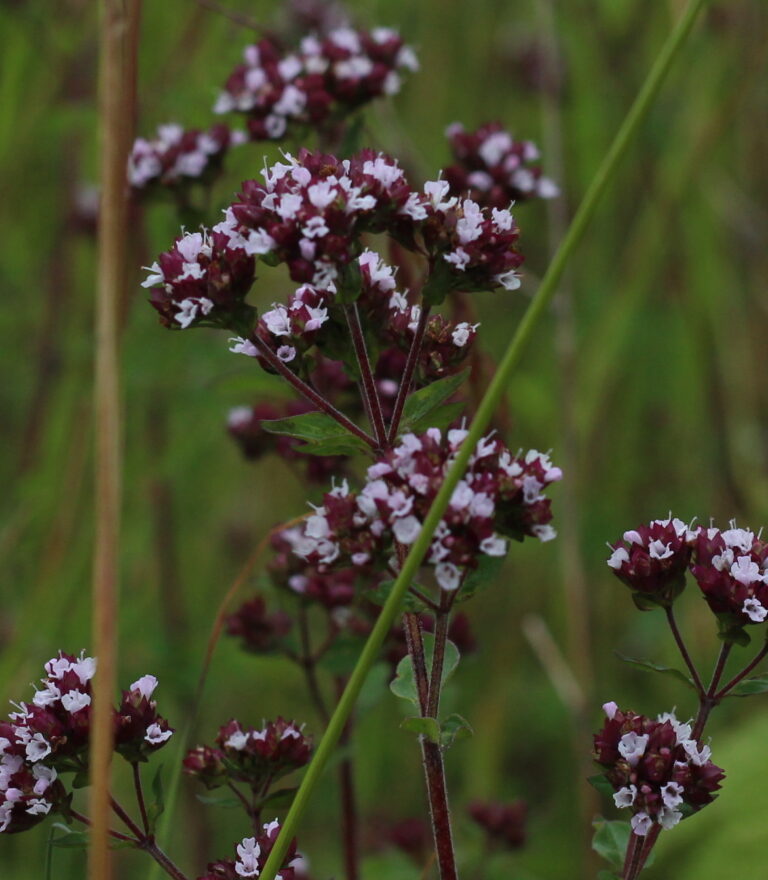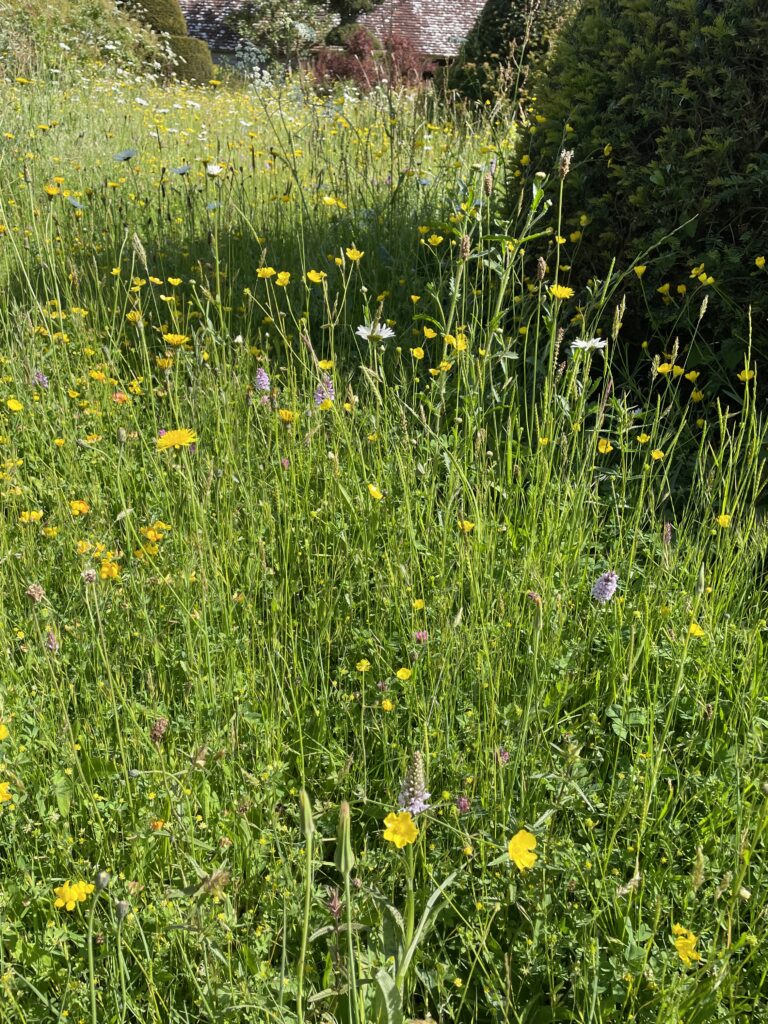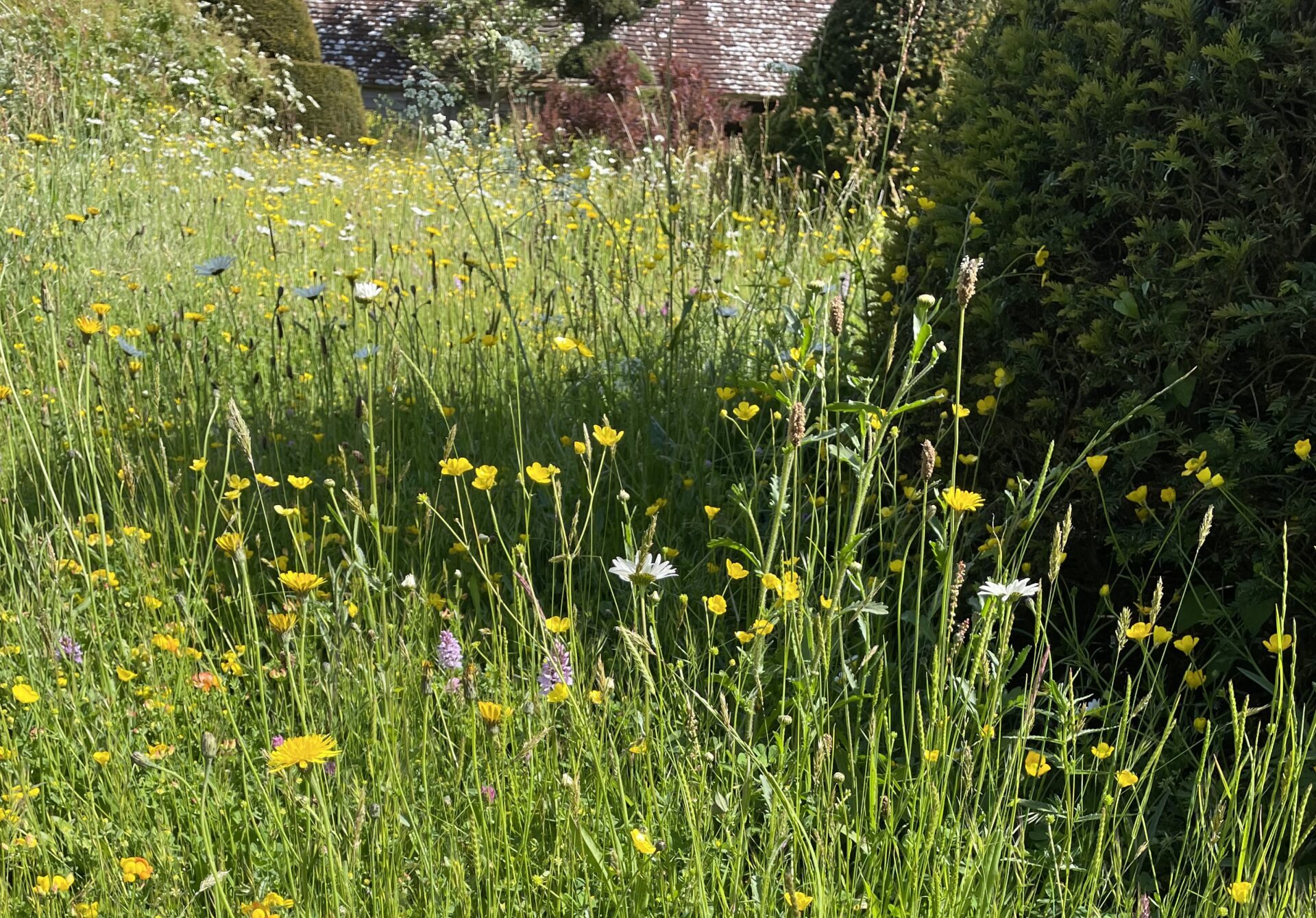We asked Melene to tell us more about the mini-meadow in her garden
Do you have a lawn and did you leave part of it as a meadow?
Yes we have one lawn for playing and sitting on. The front lawn we reduced to a grass path in order to have more plants.
The first change we made in an empty plot 25 years ago was to leave a strip of lawn unmown for our toddler to run around. It is narrow so it is easier to manage, in the middle so it has plenty of sun and a crescent shape to follow the shallow slope and to vary the microclimate at the edges.
As it had no wildflowers I planted for pollinators from late February onwards Scilla, Crocus, Grape Hyacinths, Anemone Blanda (Greek), a Cowslip, blue Bugle/Ajuga, an Ox-eye Daisy, a blue Meadow Cranesbill.
In theory it was a cheap and quick way to have more flowers with space to self-seed and to disguise the dying leaves of bulbs in the grass.
In practice despite our light soil the thick meadow grasses greatly limit what will succeed. The Cowslip has not expanded and seeded like the Primroses do in the finer lawn grasses.
Ox-eye daisy needs some thin well raked ground for new seedlings to replace the 3 year old plants so this year it had seeded prolifically into the borders instead.
Only 1 self sown Cranesbill appeared. It has a beautiful cut leaf but most other Geraniums from a flower border may be divided into new plants to plant in grass.
In order to establish self seeding Marjoram for late summer I have had to weed some bare patches in the middle.
Bugle is very successful with its runners rooting into the turf.
What Insects use the mini meadow?
Early Buff Tailed bumblebees like Crocus
Anemone blanda and Scilla attract Honeybees
Red Tailed bumblebees and the black Hairy Footed Flowerbee like Grape Hyacinths in April
Bugle gets a solitary bee not seen later
Green flower beetles sit on the Ox-eye daisies with 2 or 3 tiny pure white Crab Spiders and sometimes a hoverfly but not the larger bees.
Geraniums (blue etc not red ‘Pot Geraniums) are visited by Honeybees. Marjoram seems to attract most pollinators.
A Field grasshopper may buzz on a log in the long grass but they are more likely to be heard in the hottest edges of the borders where there are bricks or flints or wood to bask on. Plants leaning over the edge of the lawn mean the ground is hotter and drier than in the long grass. They move as the shadows move around.
There are 2 anthills which get pulled apart by an animal at night and small brown moths in the grass.
What could you do differently for wildlife in your mini meadow?
1. Even though we have a light soil there would be more flowers for bees if we had weeded out more grass and mown it short and raked hard at the end of August instead of trimming it at about a foot high. It is always flattened by cats and foxes at night anyway.
2. Planting is easier than sowing seed. I have begun moving Alliums into the grass.
3. Although our garden benefits from the shelter of trees and large bushes in all the gardens nearby, the middle is often still draughty from backwash off the house and so ignored by bees . They prefer the shelter of the mixed borders
We could plant herb bushes around the meadow strip but it would no longer be a sweeping open space and they would need individual attention to grow well in the grass. A ‘no dig’ flowers with shrubs border would be easier!
A single clipped bush in the centre of a level square of meadow would have a warm side to bask with a dry edge to retreat or breed. 4 small logs around the stem would add more shelter for Frogs and Sloworms. With a neatly mown edge it would fit into the rest of the garden without looking forgotten.
A sunny bank with rubble has all the benefits: extra heat storage means earlier flowers and more hours a bee can feed, wind shelter, drier ground for grasshoppers etc, thinner grass in the dry ground so flowers survive.
Which gardens have inspired you?
Great Dixter’s Topiary Lawn (meadow) and the entrance gate small meadow, and the orchard.
Le Jardin Plume. Near Rouen in Normandy. The ‘Feather Garden’ lives up to its name. An abundance of flowers and grasses carefully selected for their light feathery form tightly knit as in a meadow. The rest of the garden is also stuffed with flowers for pollinators.
Worth a read is Pam Lewis’s accounts of her various garden meadows at Sticky Wicket in Dorset
Melene
Thanks so much for sharing! We would love to hear about the successes and challenges in your meadow or wildlife garden, do share your stories. You can email info@renaturingseaford.org or use the form on the website
Editor









